
Overview
You might be wondering why ongoing training is such a big deal for operational success. Well, it turns out that it’s pretty crucial! Not only does it enhance employee productivity, but it also boosts job satisfaction and fosters a culture of continuous improvement. For instance, did you know that organizations investing in ongoing training see a whopping 27% increase in labor productivity? Plus, there’s a 94% higher chance of keeping employees around. That’s some serious impact on both individual and organizational performance! So, let’s dive into how this can benefit you and your team.
Key Highlights:
- SowFlow provides innovative documentation solutions for managing educational materials, simplifying complex procedures into step-by-step instructions.
- Streamlined documentation enhances onboarding, keeps staff informed, and improves team efficiency.
- 70% of organisations using blended learning successfully integrate face-to-face and online instruction, highlighting the importance of clear documentation.
- Ongoing training reduces compliance risks and fosters a culture of responsibility, boosting employee confidence and organisational integrity.
- Companies prioritising ongoing training see a 27% increase in labour productivity and a 92% higher likelihood of rolling out new products.
- Effective development programmes can reduce workplace errors and enhance employee performance.
- Utilising technology in training, such as LMS and mobile apps, creates personalised and interactive learning experiences.
- Companies using LMS report a 218% increase in revenue and a 24% rise in profit margins due to effective training programmes.
- Ongoing training leads to a 25% rise in productivity and a 20% boost in staff loyalty.
- 94% of employees are more likely to stay at a company that invests in their development, emphasising the importance of training for retention.
- Recognition programmes linked to ongoing training can lead to a 21% increase in profitability.
- 68% of workers consider development essential for job fulfilment, with organisations investing in education seeing a 33% boost in satisfaction ratings.
- Strategic planning for ongoing training involves needs evaluations, setting clear objectives, and regularly assessing educational programmes to ensure relevance.
Introduction
In a world where change is happening faster than ever, you might be wondering how organizations can keep up. It’s crucial to equip your workforce with the right skills and knowledge to thrive. That’s where ongoing training comes into play—it’s not just a buzzword; it’s a game-changer. This approach brings a host of benefits that boost both operational efficiency and employee satisfaction. But here’s the catch: how do you effectively roll out these training programs to unlock their full potential? What are the real perks of continuous development, and how can organizations tap into them to not only check off compliance boxes but also create a vibrant culture of innovation and engagement? Now, let’s dive into this together!
SowFlow: Streamlined Documentation Solutions for Ongoing Training
You might be wondering how SowFlow can change the game when it comes to managing educational materials. Well, it’s all about innovative documentation solutions that make creating and maintaining essential resources a breeze. By breaking down complex procedures into simple, step-by-step instructions, SowFlow helps organizations keep their educational content fresh and easily accessible. This approach not only cuts down on the time spent on documentation but also ensures that your team can quickly find the information they need, facilitated by ongoing training to nurture a culture of continuous improvement.
Now, let’s dive into how SowFlow's intuitive tools can really enhance your development processes. Imagine smoother onboarding for new hires and keeping your existing staff in the loop about best practices and updates. Plus, with SowFlow’s instant documentation solution, creating user guides and making updates is effortless. This streamlining of process standardization and knowledge sharing can significantly boost team efficiency.
Firms that have adopted these efficient documentation practices have seen some impressive results. In fact, about 70% of organizations using blended learning techniques are successfully merging face-to-face and online instruction. As industry leaders often point out, clear documentation is key to fostering engagement and retention in development programs. This clarity ultimately leads to a more skilled and adaptable workforce.
To really make the most of SowFlow's solutions, it’s a good idea for organizations to regularly review and update their documentation. Keeping things fresh with the latest practices and insights will only enhance the benefits you reap from this innovative tool.
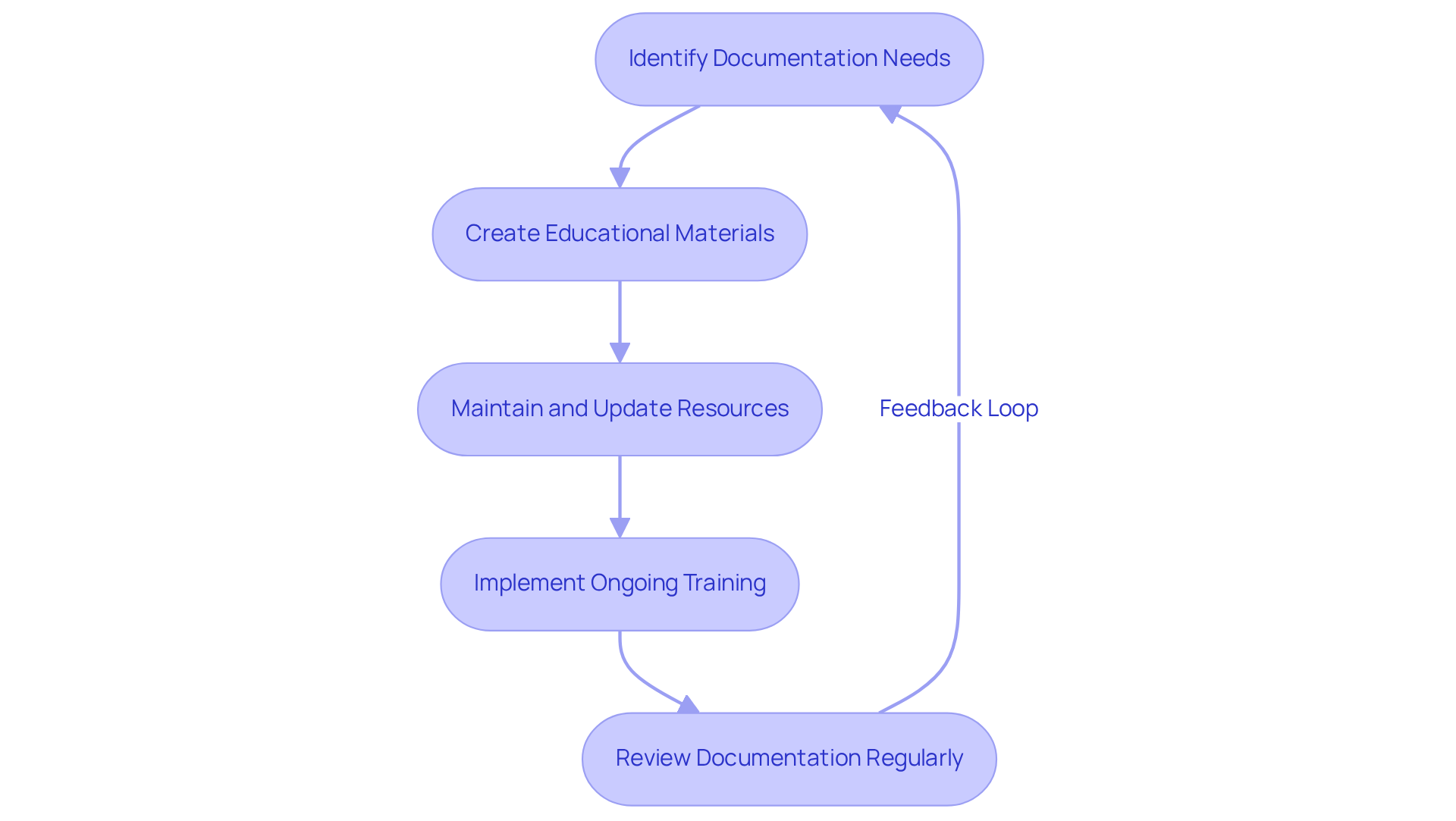
Compliance with Regulations: The Necessity of Ongoing Training
You might be wondering why continuous development is such a big deal in today’s ever-changing regulatory landscape. Well, keeping your staff updated on legal obligations, company guidelines, and ethical norms is crucial. Regular practice sessions ensure everyone is on the same page, and by integrating compliance instruction into ongoing training initiatives, companies can significantly reduce the risk of breaches while fostering a culture of responsibility.
Now, let’s dive into why this proactive approach is a win-win. Not only does it shield the organization from potential legal troubles, but it also boosts staff confidence. When employees feel knowledgeable about navigating regulatory frameworks, they’re more empowered to uphold ethical standards. This, in turn, leads to improved organizational integrity and performance. Plus, compliance officers often emphasize that consistent education is key to creating an environment where everyone feels encouraged to act ethically. So, how about incorporating compliance into your ongoing training efforts? It’s a step in the right direction for everyone involved!
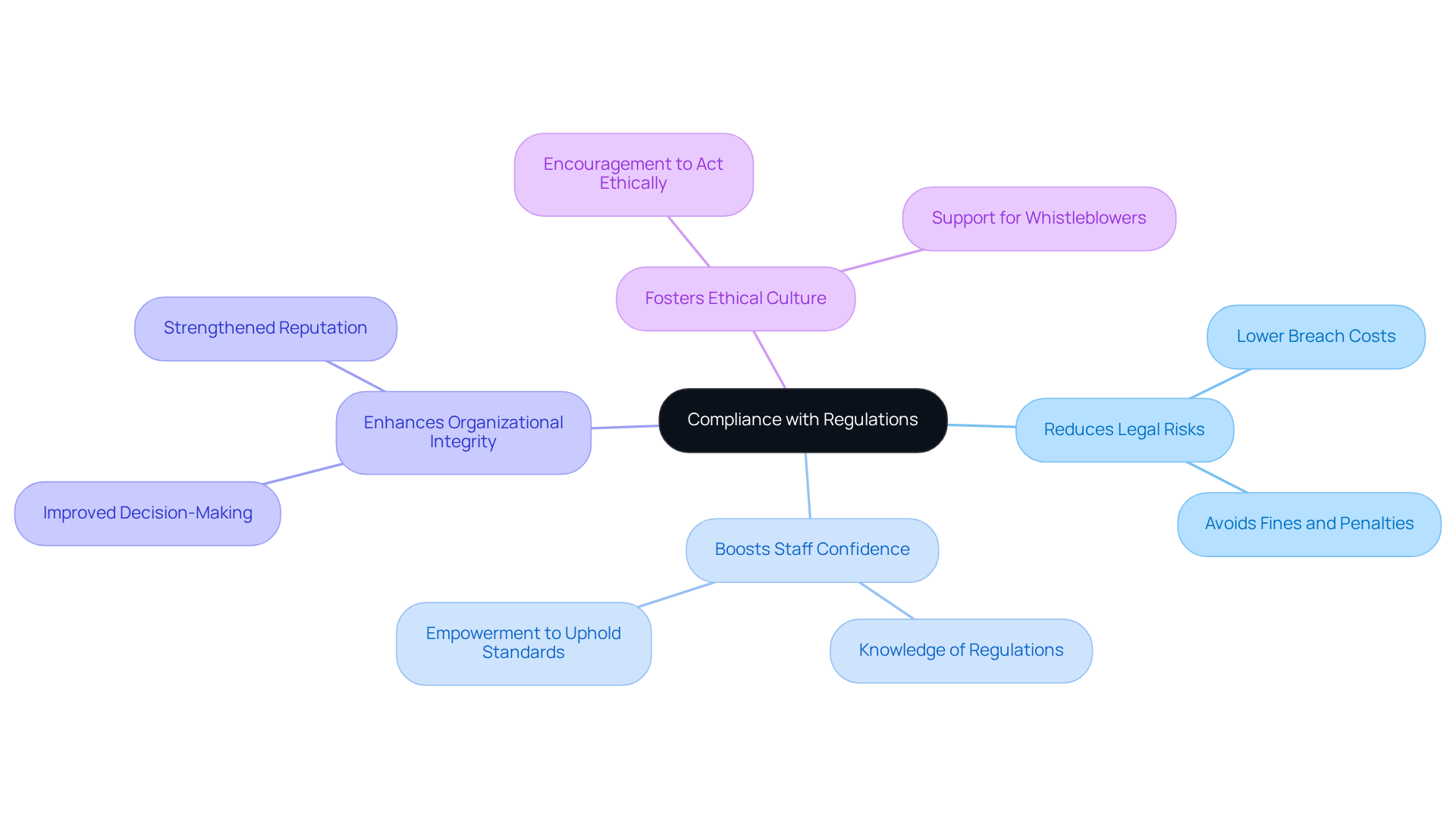
Staying Current: The Importance of Industry Best Practices in Ongoing Training
In today's fast-paced business world, you might be wondering how continuous development can keep up with the latest industry best practices. It's crucial for making sure employees are not just aware of current trends but also feel empowered to put innovative solutions into action. Frequent updates to educational resources are key for organizations looking to maintain a competitive edge and boost operational effectiveness. Did you know that companies that prioritize ongoing training see a 27% increase in labor productivity compared to those that don’t invest in skill development? By creating a culture of continuous improvement, businesses can inspire their teams to explore and adopt new strategies that drive success.
Speaking of success, industry experts have noted that effective development programs can significantly cut down on workplace errors and enhance overall employee performance. Plus, organizations that incorporate ongoing training into their fabric are 92% more likely to roll out new products and processes. This really underscores how vital updated learning is for fostering innovation and adaptability in the workforce.
As Anastasia Masadi, a Product Owner, puts it, "SowFlow has been a game changer in the way we document work and deliver to our clients. I do not need to capture each screenshot individually, and do not even have to exit the browser while I am creating SOPs and instructional materials. SowFlow gave me time from my life back." This shows how SowFlow not only streamlines the documentation process but also significantly boosts the effectiveness of educational initiatives.
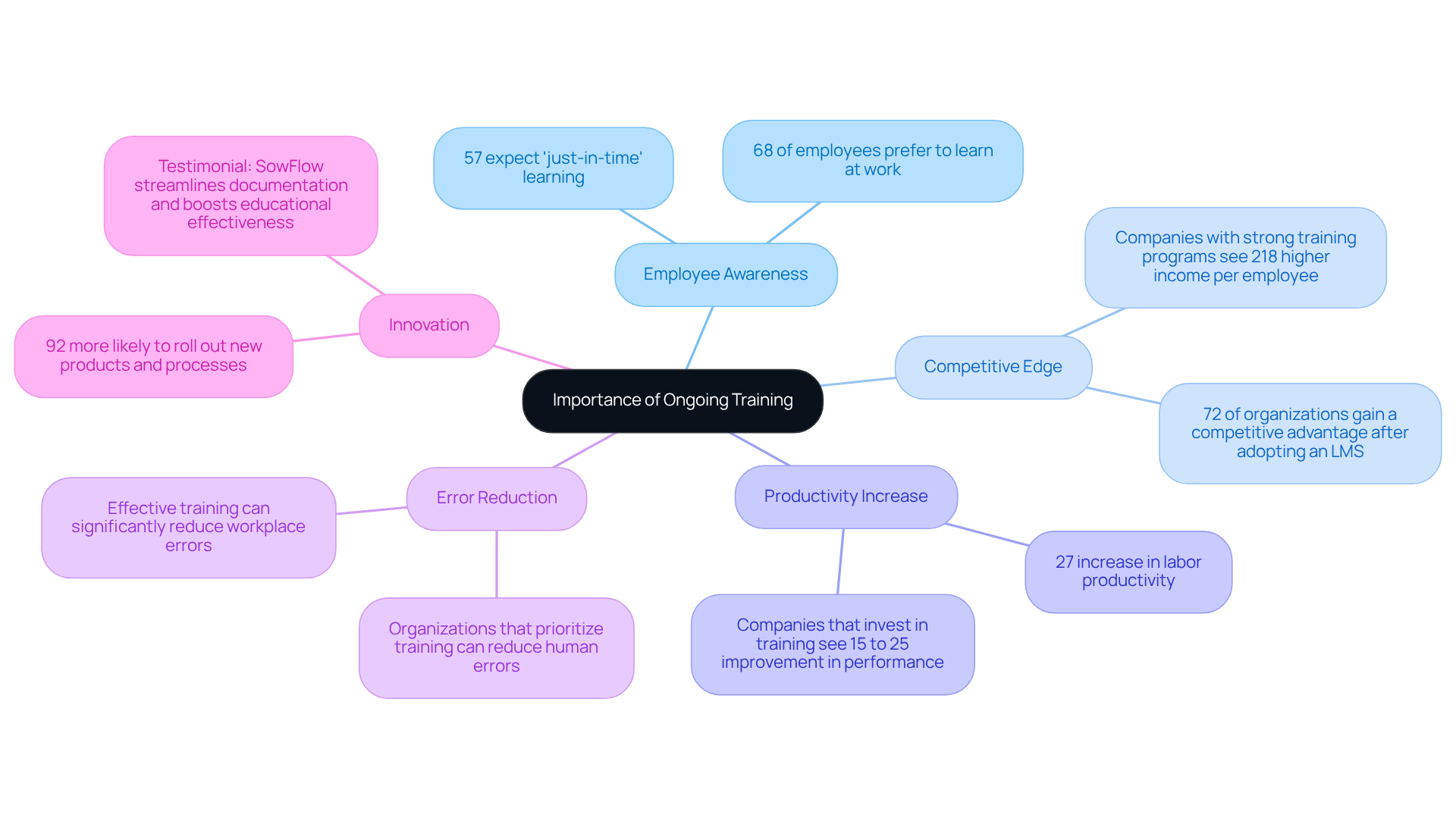
Embracing Technology: How Ongoing Training Drives Innovation
You might be wondering how technology can really boost ongoing training programs. Well, incorporating tools like Learning Management Systems (LMS), virtual reality (VR), and mobile education apps can make a huge difference in the educational experience for employees. These advanced tools create interactive and personalized sessions that cater to various learning styles and preferences. Speaking of that, SowFlow steps in to enhance this process by offering an intuitive user guide creation experience. This means your teams can access essential documentation instantly, cutting down on those unnecessary meetings. Pretty neat, right?
This capability doesn’t just keep everyone engaged; it also sparks innovation! Employees feel empowered to explore new tools and techniques that can elevate their performance. With SowFlow, organizations can easily update and revise documentation, making sure that instructional materials stay relevant in our ever-changing business landscape. For example, companies using LMS have reported a whopping 218% increase in revenue and a 24% rise in profit margins. That’s some serious return on investment from effective development programs!
And here’s something to think about: 92% of staff members believe that well-structured development positively impacts their engagement. So, it’s clear that incorporating these technologies into your educational strategies isn’t just a good idea; it’s essential for fostering an engaged and motivated workforce. Now, let’s dive into how you can start implementing these changes in your organization!
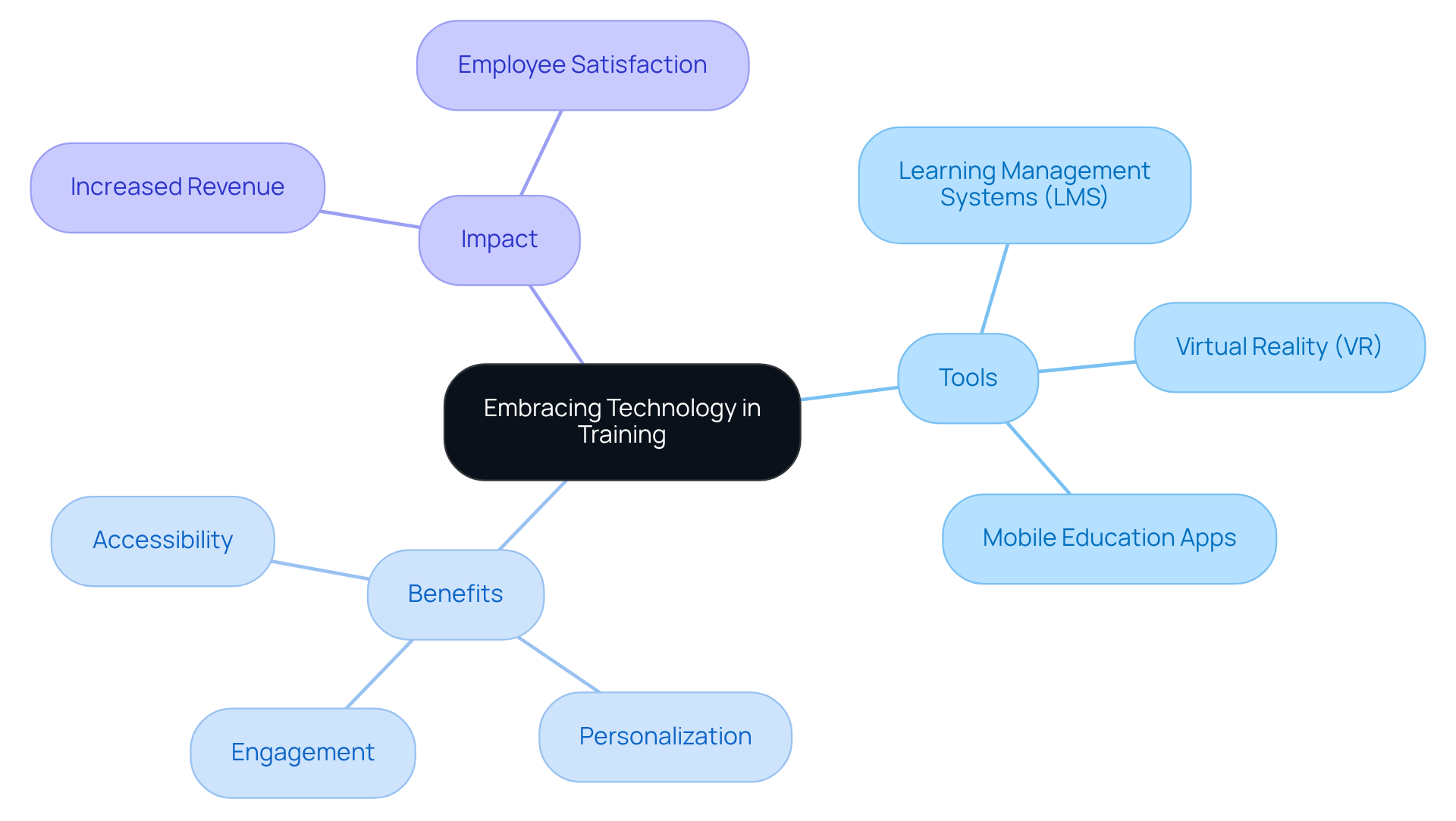
Skills Improvement: Unlocking Employee Potential with Ongoing Training
You might be wondering why continuous training is such a big deal. Well, it’s all about unlocking individual potential and boosting those skill sets! When organizations provide regular opportunities for skill development, they’re not just keeping up with the competition; they’re building a workforce that can tackle new challenges head-on. This commitment to ongoing training doesn’t just pump up staff confidence; it also leads to a significant jump in productivity and job satisfaction.
For example, companies that engage in ongoing training experience a remarkable:
Pretty impressive, right? Plus, those that prioritize education can increase their revenue by 56% more than those that don’t. As employees pick up new skills, they become invaluable assets to their organizations, driving success and growth.
And here’s a fun fact:
- 76% of employees are more likely to stick around at a company that offers development opportunities.
This really highlights how crucial training is for keeping talent. Take a look at the Financial Times—they implemented an extensive educational strategy, and guess what? They saw measurable increases in productivity. In today’s fast-paced job market, ongoing training is essential for cultivating a skilled workforce that can meet the demands of modern business.
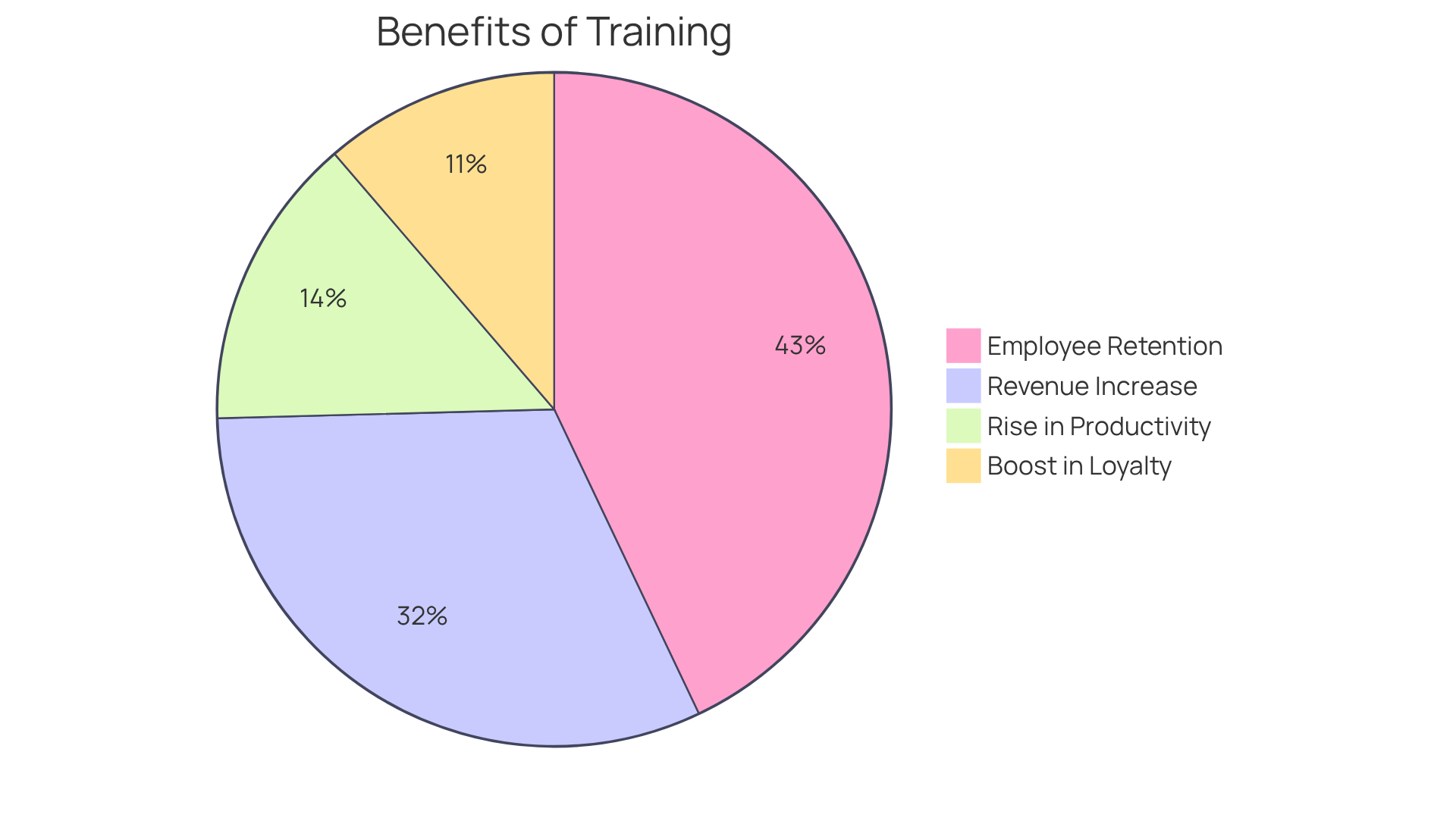
Employee Engagement: Incentivizing Learning Through Ongoing Training
You might be wondering how continuous development can really boost workforce engagement. Well, it’s all about creating a culture that values growth and advancement. When organizations focus on developing their staff, they not only foster a sense of worth and inclusion but also see higher retention rates. How? By incentivizing education through structured recognition programs, clear career advancement pathways, and even ongoing training experiences, companies can significantly increase participation in training initiatives.
Think about it: engaged individuals are more likely to pick up new skills and knowledge, which leads to better performance and greater job satisfaction. In fact, did you know that 94% of employees say they would stick around longer with a company that invests in their education and development? That really shows how workforce engagement can drive organizational success! Plus, organizations that implement effective recognition strategies often see a 21% rise in profitability. It’s clear that acknowledging and valuing contributions during the learning process is key.
But here’s the kicker: only 52.6% of employees report having recognition programs at their workplace. That’s a big gap that businesses can fill to boost engagement! And get this—71% of employees would be less likely to leave if they received more recognition. This really underscores the importance of recognition in retention strategies. As Richard Branson puts it, 'Your staff members are your greatest asset.' Investing in their development is essential for long-term success. Jack Welch also points out that workforce engagement is a vital indicator of organizational performance. So, let’s dive into how cultivating a culture of continuous learning can make a real difference!
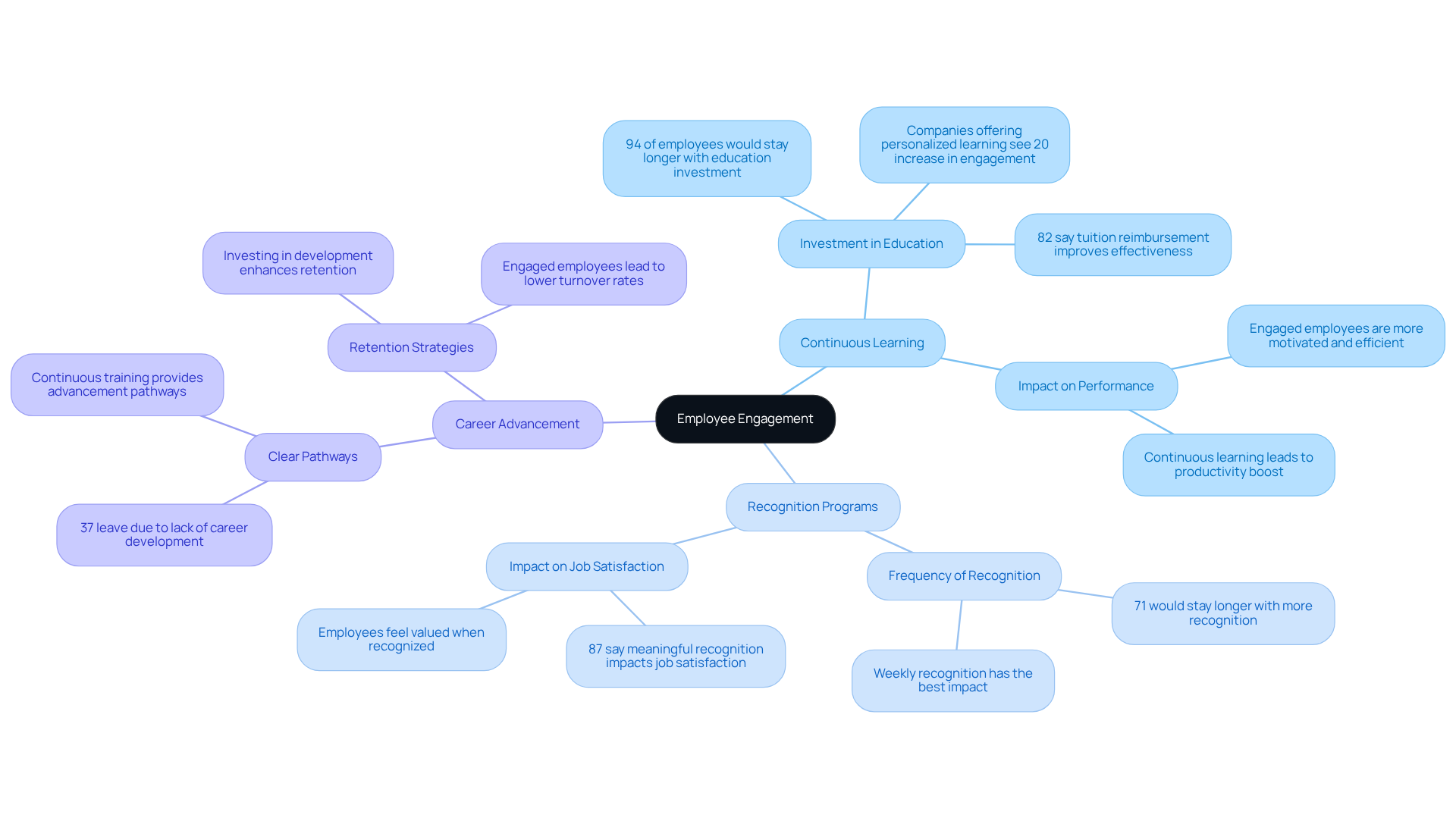
Job Satisfaction: The Role of Ongoing Training in Employee Happiness
You might be wondering how continuous development ties into job satisfaction for staff. Well, when companies show they care about professional growth, employees feel valued and content in their roles. And this isn’t just a feeling—research shows that:
- 68% of workers consider development essential for job fulfillment.
- Organizations that invest in staff education see a 33% boost in satisfaction ratings.
Now, think about this: companies that prioritize continuous development foster a positive work environment that sparks motivation and engagement. This leads to lower turnover rates and improved productivity. For example, businesses with strong learning cultures are:
- 92% more likely to innovate, which not only lifts staff morale but also drives organizational success.
Zig Ziglar once said, "The sole aspect more detrimental than educating staff and losing them is failing to educate them and retaining them." By investing in ongoing training, companies can significantly reduce turnover, as:
- 94% of employees would stick around longer at a firm that offers development opportunities.
Ultimately, promoting a culture of ongoing training boosts worker satisfaction and contributes to the company’s overall success.
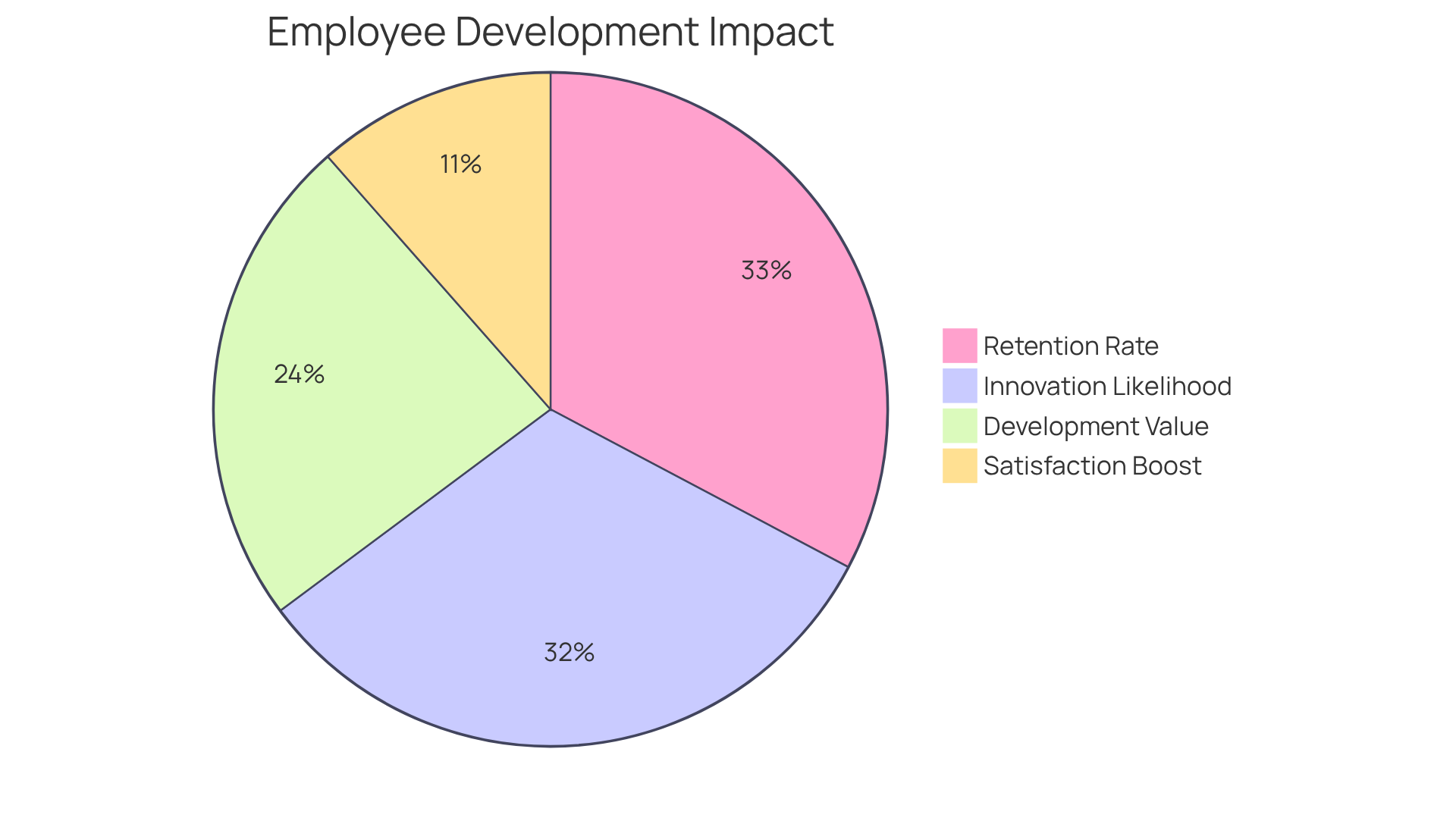
Career Advancement: Promoting Internal Growth Through Ongoing Training
You might be wondering how ongoing training can really boost your career within a company. Well, it acts as a key catalyst for career progression! By providing ongoing training to equip employees with essential skills and knowledge, companies can create clear pathways for internal mobility. This not only helps in keeping top talent around but also builds a culture of loyalty and commitment among the staff. When employees see opportunities for advancement, they’re much more likely to dive deep into their roles, which ultimately contributes to the organization's long-term success. In fact, did you know that 94% of employees would stick around longer at firms that support their career development? That really highlights the strong connection between skill development and retention.
Now, let’s dive into what learning and development (L&D) professionals think—almost 89% believe that upskilling is crucial for workforce success. By emphasizing ongoing training, companies can cultivate a skilled workforce ready to tackle new challenges and drive operational success. Plus, it’s worth noting that 37% of staff leave due to a lack of career advancement options. This underscores the importance of investing in skill development. Companies with robust staff development programs see a whopping 218% greater revenue per worker compared to those without, which is a pretty compelling reason for businesses to invest in their people. And here’s another interesting tidbit: employees at companies that promote internal mobility tend to stick around for an average of 5.4 years. That really shows the long-term benefits of encouraging internal advancement through development!
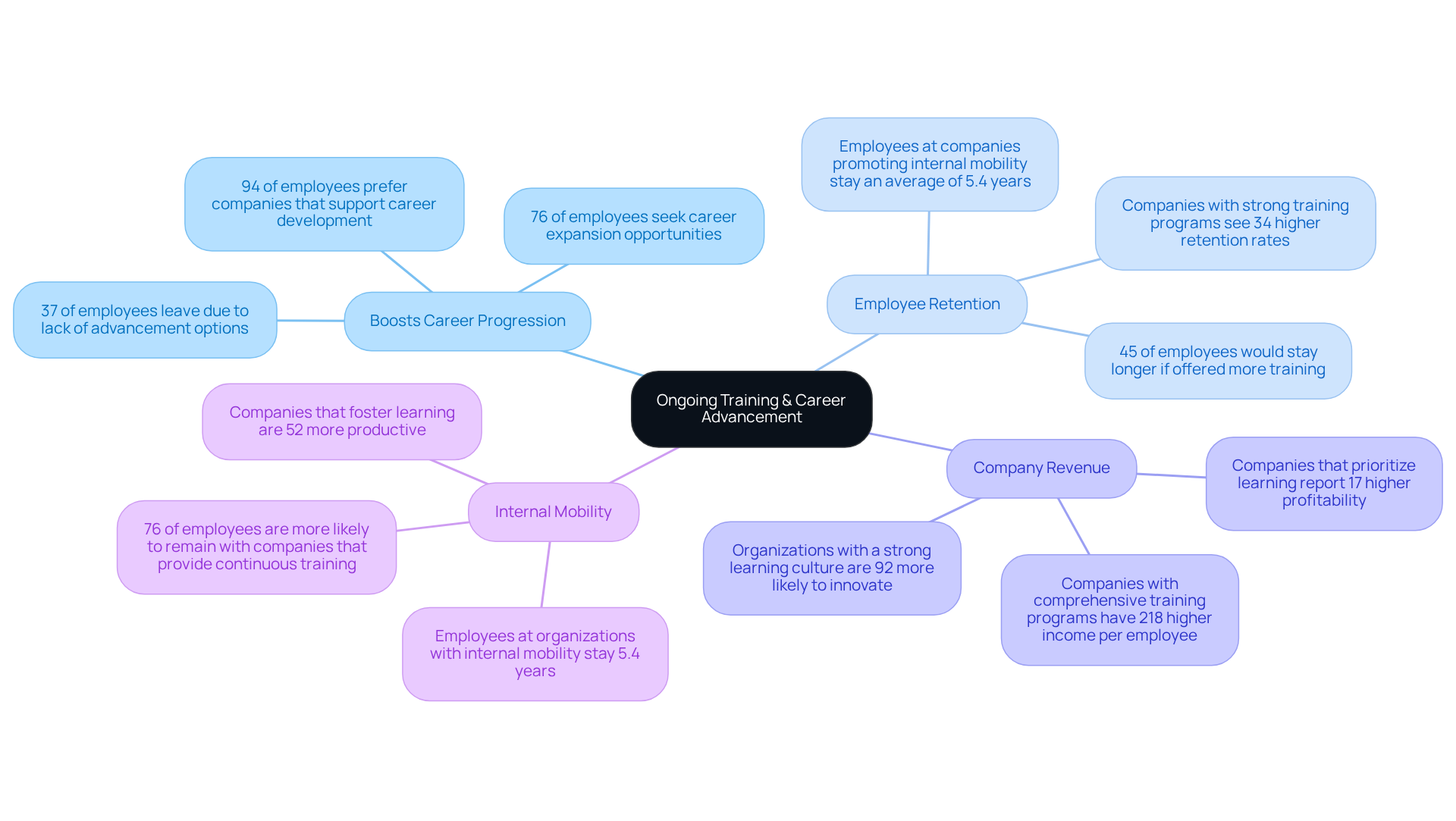
Trends and Statistics: Leveraging Data to Enhance Ongoing Training
You might be wondering why employing trends and statistics is so crucial for enhancing development programs. Well, by digging into the data surrounding staff performance, engagement, and skill gaps, organizations can really tailor their initiatives to meet the specific needs of their workforce. For example, did you know that firms with extensive development programs report a whopping 218% higher income per employee compared to those without structured education? Plus, they enjoy a 24% higher profit margin overall!
Now, here’s something to think about: 91% of workers are looking for customized development that’s relevant to their roles, and 68% prefer learning right in the workplace. This really emphasizes the importance of personalized approaches that incorporate ongoing training into daily activities. Keeping an eye on market trends and listening to staff feedback can help companies refine their development strategies, ensuring ongoing training is effective in fostering workforce growth and boosting overall productivity.
Speaking of productivity, organizations that invest in ongoing training see a 17% increase in performance. That really highlights the direct link between education and improvements in productivity! As Henry Ford wisely said, "The only thing worse than educating your employees and having them leave is not educating them and having them stay." This really drives home the point about the essential nature of effective instruction.
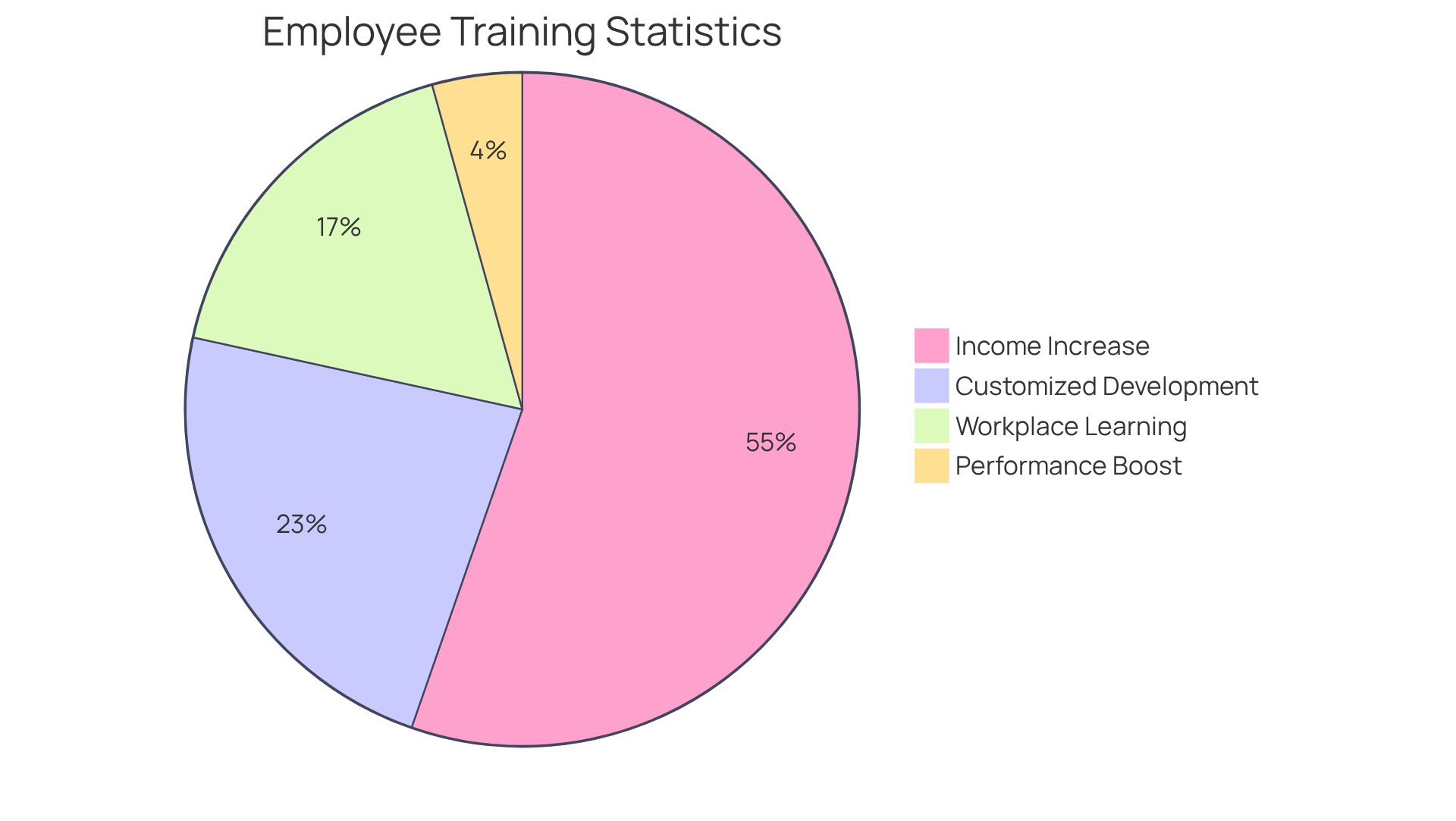
Strategic Planning: Crafting an Effective Ongoing Training Program
Is creating an effective ongoing training program possible? It all starts with some strategic planning that aligns with your organization's goals. You might be wondering where to begin—well, a thorough needs evaluation is essential. This step helps pinpoint skill gaps and development needs, ensuring that you not only know what your team needs to learn but also choose the best methods for ongoing training. Did you know that organizations focusing on needs evaluations see an impressive 218% increase in revenue per worker? That’s a clear win for targeted development programs! Plus, 91% of employees prefer customized and relevant development opportunities, which can boost their motivation and performance. Tailored educational programs really do make a difference.
Now, let’s talk about setting clear objectives. This is crucial for steering the development process in the right direction. Ongoing training, through regular assessment and updates of your educational programs, keeps them relevant and effective, especially in today’s fast-paced business environment. Ongoing training is linked to a 17% boost in productivity and a 21% increase in profitability—talk about operational success!
Take a cue from organizations like Deloitte. They’ve shown that companies with a strong learning culture are 92% more likely to innovate. This strategic approach not only maximizes your team's potential but also nurtures a culture of continuous improvement, driving overall success. As the Work Institute puts it, "Understanding the specific needs of your workforce is the foundation of any successful development initiative."
So, how can you implement effective needs assessments? Operations managers should regularly check in with employees to gather feedback on their development needs and preferences. This ensures the support you provide aligns with their evolving demands. By weaving this practice into your training planning, you can make sure you’re truly meeting the needs of your workforce.
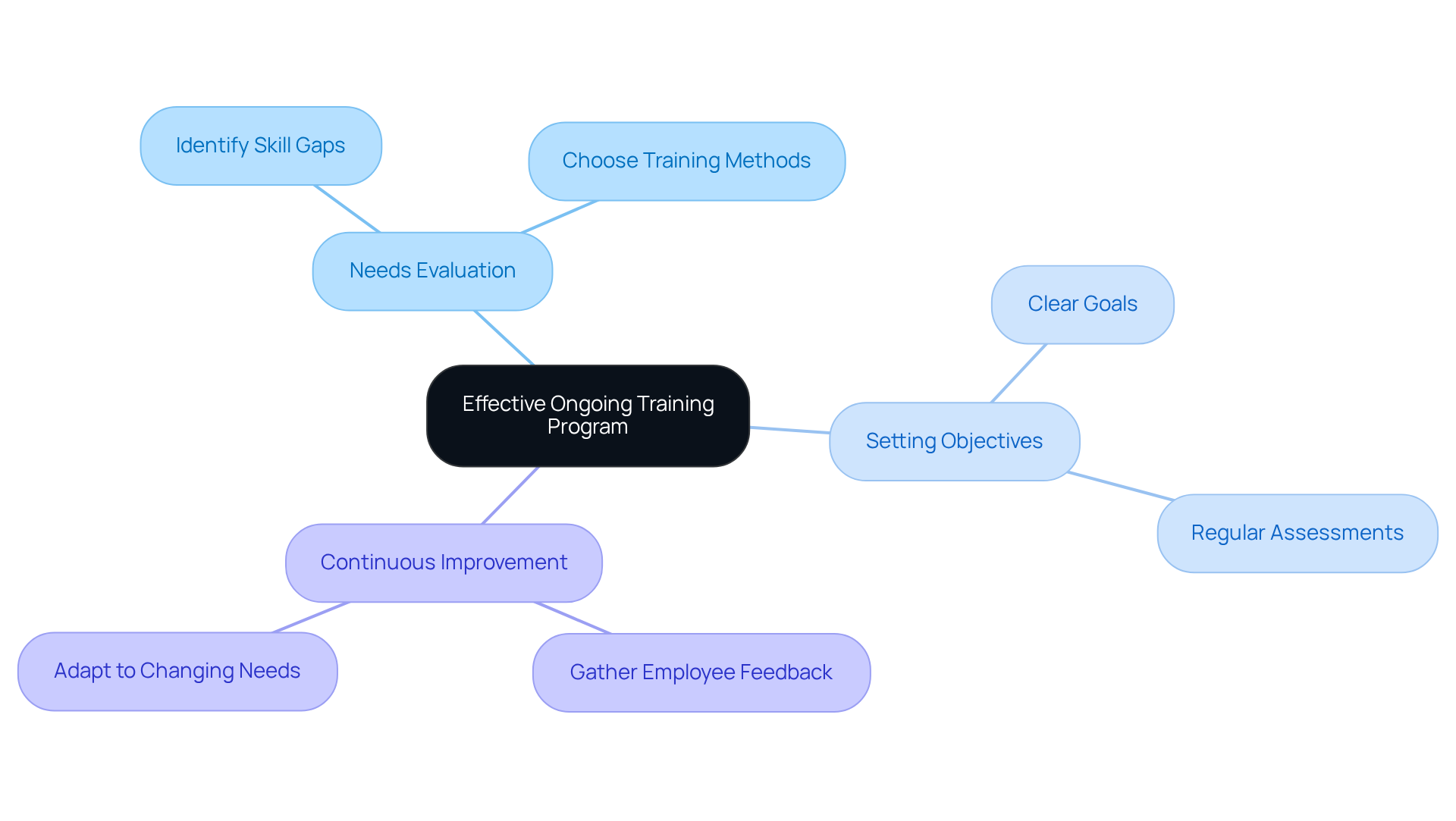
Conclusion
Ongoing training is super important for keeping operations running smoothly. It’s like the backbone of employee development, compliance, and growth for the whole organization. When companies invest in continuous education, they’re not just upgrading their workforce’s skills; they’re also creating a culture of adaptability and innovation that’s absolutely crucial in today’s fast-paced business world.
You might be wondering about the perks of ongoing training. Well, throughout the article, we’ve highlighted some key benefits, like:
- Improved employee engagement
- Boosted job satisfaction
- Better compliance with regulations
Plus, when you throw in technology—like SowFlow's streamlined documentation solutions—it makes training resources way more accessible and effective. Organizations that make ongoing training a priority often see big wins in:
- Productivity
- Employee retention
- Overall performance
So, here’s the deal: committing to ongoing training isn’t just a strategy for individual growth; it’s a smart investment in the future of your organization. By nurturing a culture that values continuous learning and skill development, companies can really unlock their employees' potential and drive long-term success. Embracing these practices is key for any organization that wants to thrive in an ever-evolving market. Now, isn’t that something worth thinking about?
Frequently Asked Questions
What is SowFlow and how does it assist in managing educational materials?
SowFlow is an innovative documentation solution that simplifies the creation and maintenance of educational resources by breaking down complex procedures into easy, step-by-step instructions. This helps organizations keep their content fresh and easily accessible.
How does SowFlow enhance onboarding and training processes?
SowFlow facilitates smoother onboarding for new hires and keeps existing staff informed about best practices and updates through its instant documentation solution, which makes creating user guides and updates effortless.
What results have organizations seen from adopting SowFlow's documentation practices?
Organizations that have adopted efficient documentation practices, like those using blended learning techniques, have reported that about 70% are successfully merging face-to-face and online instruction, leading to improved engagement and retention in development programs.
Why is ongoing training important in the context of compliance with regulations?
Continuous development is essential for keeping staff updated on legal obligations, company guidelines, and ethical norms. It reduces the risk of breaches and fosters a culture of responsibility within the organization.
How does ongoing training contribute to employee confidence and organizational integrity?
Regular compliance training empowers employees with knowledge about navigating regulatory frameworks, which boosts their confidence and encourages them to uphold ethical standards, ultimately improving organizational integrity and performance.
What benefits do organizations gain from prioritizing ongoing training and industry best practices?
Organizations that prioritize ongoing training experience a 27% increase in labor productivity and are 92% more likely to successfully roll out new products and processes, fostering innovation and adaptability in the workforce.
How has SowFlow impacted the documentation process according to industry experts?
Industry experts, like Product Owner Anastasia Masadi, have noted that SowFlow has significantly streamlined the documentation process, allowing users to create standard operating procedures and instructional materials without extensive effort, thereby saving time.
👍
What others are liking
5 Steps to outline your ideal documentation structure
5 MINS READ
Where to start the your journey of mapping out your ideal documentation structure, aligning it with the very heartbeat of your organization?
Defining a winning level of detail in your process
3 MINS READ
What is too much detail, and what is too little? This article described in that winning level detail about what detail is enough.





